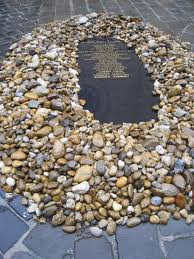The Dohany
Street Synagogue, also known as the Great Synagogue, in Budapest, Hungary,
is
the largest synagogue in Europe and one of the largest in the world (Rick
Steve’s and greatsynagogue.hu say it is the second largest, behind the Temple
Emanu-El in New York, and Wikipedia says it is the fifth largest behind two in
Jerusalem, one in Ukraine and one in New York). It was built between 1854 and 1859
and is a center of Neolog Judaism, a mainly Hungarian speaking reform movement
within Judaism, somewhat comparable to Conservative Judaism in the U.S.
There appear
to be disparate influences on the design. One source said the design was loosely
based on the Temple of Solomon in Jerusalem,
particularly the two large towers,
which are not typical of synagogues, but are of Christian churches.
Other elements
that more resemble Christian churches than synagogues include the large round
stained glass windows,
a pipe organ (played by Franz Liszt at the inauguration -
revealing that this was built by a very progressive branch of Judaism as
Orthodox Jews would not play an organ on the Sabbath),
pews with kneelers, a
pulpit,
and a floor plan much like a basilica, with three aisles and two
balconies.
It has been referred to as the “most beautiful Catholic synagogue in
the world.” I loved the Moorish influence. It felt like it could be in Spain, at
the Mezquita in Cordoba, or the Alhambra in Grenada.
This was perhaps an
artistic nod to the many Hungarian Jews that were descended from the Sephardic
Jews expelled from Spain in 1492. Two
large chandeliers appear to be inspired by concert halls of that time.
The ark,
behind the burgundy curtain, contains 25 Torah scrolls which were preserved by
Catholic priests from other synagogues destroyed during World War II (they were
buried in a cemetery).
A few other elements I enjoyed.
Beyond the
memorial garden and behind the synagogue is a Tree of Life sculpture
erected in
1990, an acknowledgement of the Holocaust that was not allowed while the Jews
were under communist rule. The willow makes an upside-down menorah
and has
approximately 4,000 metal leaves,
each etched with the name of a Holocaust
victim.
Dohany Street has Holocaust connotations as it was the border of the
Budapest Ghetto established in November 1944 shortly after the Nazi’s occupied
Budapest starting March 19, 1944. It consisted of several blocks of the old
Jewish quarter and was surrounded by a high fence and stone wall with guards.
Food was not allowed in, waste was not collected and the dead lay in the
streets. Overcrowding led to disease, such as typhoid. More than half of those
in the ghetto were sent to concentration camps. The Soviet army liberated Budapest
on January 17, 1945 during the Battle of Budapest. But during that time, the
Jewish population of Budapest was reduced from 200,000 to 70,000.
To the side of the
synagogue is a memorial garden.
Following the Nazi occupation, the Soviets dug
a mass grave at that spot to bury an approximate 2,281 Jews that died in the
ghetto. The trees and headstones there now were donated by survivors at a later
time.
Near the Tree of Life is the symbolic grave of Raoul Wallenberg, a
Swedish diplomat sent to Hungary with the instruction to do whatever he could
to save Jews from the Nazis. He gave Swedish passports to Jews and sent them to
safe houses, saving tens of thousands from death. When the Soviets arrived,
Wallenberg was arrested, accused of being a U.S. spy, sent to the gulag and
executed. The small stones are symbolic of Jewish cemeteries where pebbles are
placed on desert graves to keep animals from disturbing the remains.
A stained
glass window that stands near the symbolic grave has fire that symbolizes the
Holocaust,
the Hebrew word “Shoah” literally means catastrophe, and the curling
snake represents fascism.





































Of any we have visited, I think this is my favorite synagogue. There was so much passion here, from the beautiful, unusual architecture and art to the very intense and strident tour guide. Wonderful.
ReplyDeleteIf you are ever in Brighton, East Sussex, England, you really must visit the old shul in Middle Street, consecrated in 1875. It is an absolute gem of a high Victorian synagogue and has a most lovely interior and many gorgeous stained glass windows. It is not as large or as grand as many continental ones, but it is one of the most ornate synagogues in Europe. "The interior, described by Anthony Dale as amongst the most splendid synagogue interiors in Europe, it certainly is quite spectacular." http://www.bhhc-shul.org/middlestreet/gallery.html
ReplyDeleteWe were in Brighton years ago. If I ever get back we will visit the synagogue there. Thank you.
DeleteThe synagogue in Brighton is rarely used now and you would have to make an appointment.
ReplyDeleteDoes anyone know the artist of the stained glass window memorial in the outdoor garden?
ReplyDelete